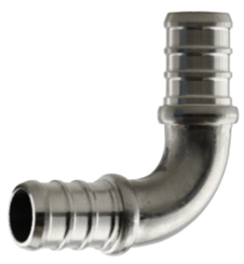Are your SSPEX series fittings designed for use with PEX A or PEX B piping?
BOTH! Our "SSPEX" Series 304 Stainless Steel Crimp PEX fittings are manufactured to ASTM 1807 and are compatible with ALL types or PEX piping, including A, B & C. 
ASTM 1807 Standard Specification for Metal Insert Fittings Utilizing a Copper Crimp Ring, or Alternate Stainless-Steel Clamps, for SDR9 Cross-linked Polyethylene (PEX) Tubing and SDR9 Polyethylene of Raised Temperature (PE-RT) Tubing.
While our SSPEX fittings are suitable for use with all three types of PEX piping you will typically see these ASTM-F1807 Crimp / Clamp Type fittings used with PEX "B" piping!
Here is why...
PEX B
Is manufactured using the Silane, or moisture Cure method and is the most common type of PEX piping. PEX B is commonly used because it less expensive than PEX A.

PEX B has all the properties required to make good connections on both ASTM-1807 (Metal) and ASTM-2159 (Plastic) Crimp type fittings which do not require expansion of the PEX pipe to make a connection.
PEX A
While PEX A it can be used with any type of PEX fitting, its use is generally limited to Cold Expansion Type fittings. It is not widely used not used for Crimp Type PEX fitting connections simply because of its higher cost due to the "Peroxide. or Engle Method of Cross -Linking" a more costly manufacturing process. PEX A is historically the only type of PEX piping that was suitable for use with metal or plastic Cold Expansion PEX (CEP) type fittings manufactured to ASTM-F1960 Standard. More recently, as things evolve, some manufacturer's PEX B PEX piping is suitable for use with CEP fittings. It is the sole responsibility of the installer to check with the manufacturer and ensure that the piping used is suitable for their particular applications.

PEX C
Is manufactured using the Electronic Irradiation, or Cold Method of cross linking and is by far the least common type of PEX piping used. It has the properties required to make good connections on both ASTM-1807 (Metal) and ASTM-2159 (Plastic) Crimp type fittings which does not require expansion of the pipe. PEX-B and PEX-C are for the most part interchangeable, the main difference the hardness, PEX-C is the softer of the two.

Although PEX C is least costly manufacturing process, its softness makes it more susceptible kinking and is likely the reason it is not commonly used.
